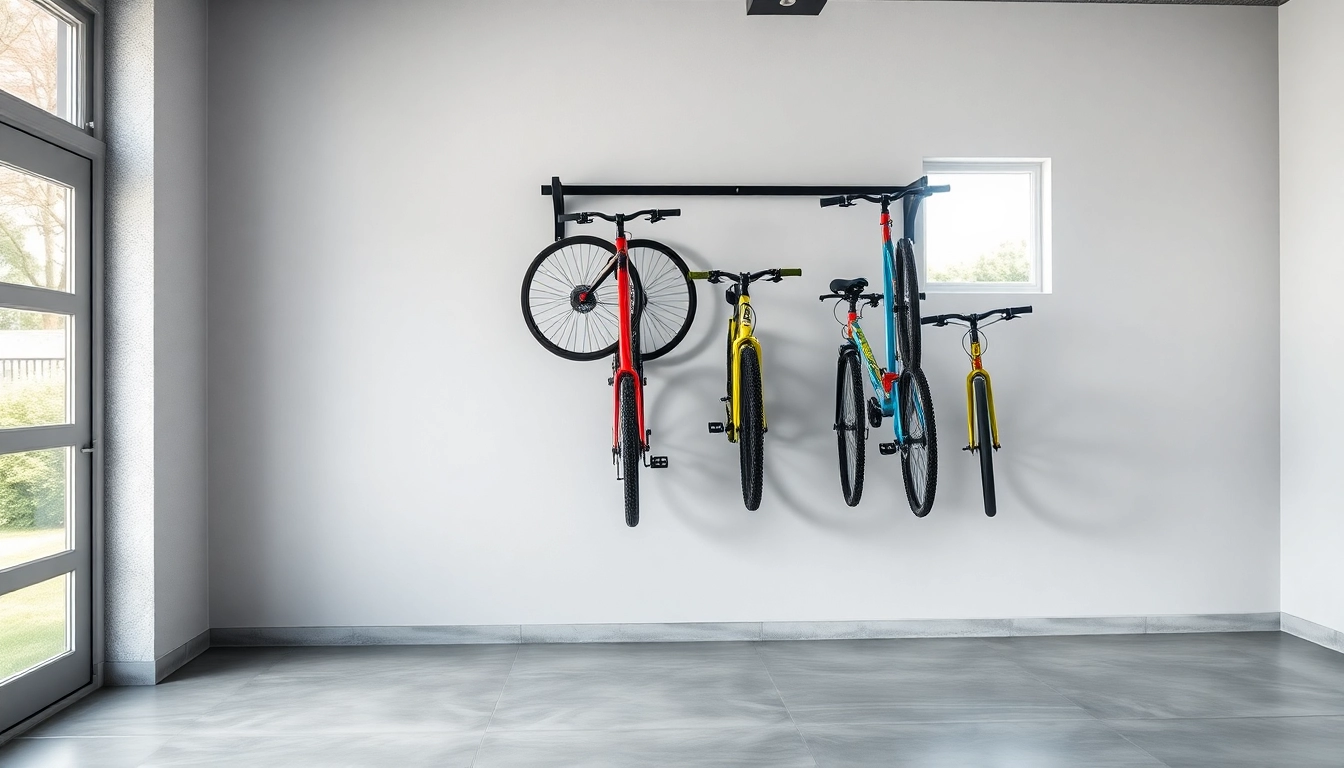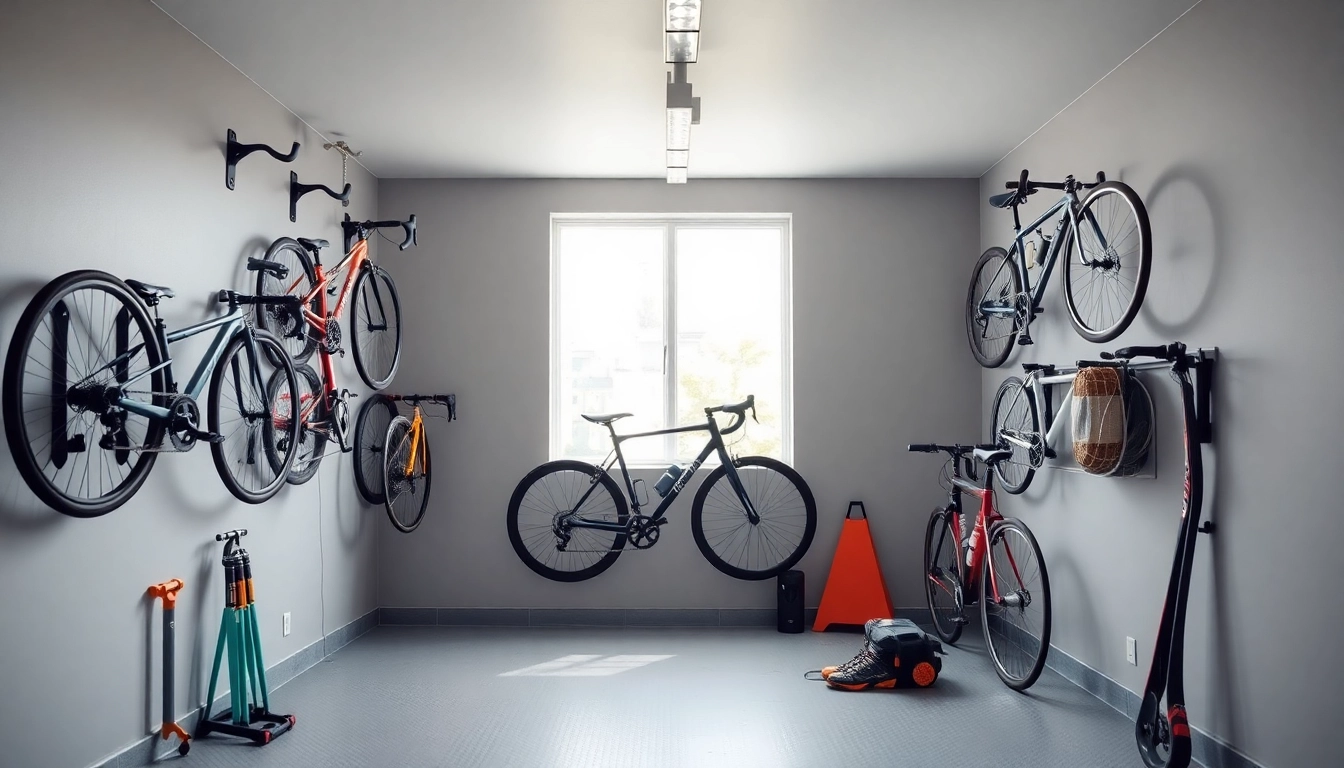Efficient Solutions for Space-saving Bike Rack Installation and Use
Understanding the Benefits of a Space-saving Bike Rack
As urban living continues to evolve, maximizing space has become a necessity for most households, particularly for avid cyclists. A Space-saving bike rack is an effective way to optimize both storage and accessibility, allowing you to keep your bike secure while minimizing clutter in both residential and commercial spaces. This section explores the primary benefits of utilizing a space-saving bike rack.
Maximizing Garage Space with Efficient Storage Arrangements
Garages often turn into cluttered storage areas, making it difficult to find space for essential items, including bicycles. A space-saving bike rack allows you to reclaim this valuable real estate by organizing your bikes efficiently. Here are several ways a bike rack can enhance your garage space:
- Vertical Storage: Wall-mounted racks and vertical hangers utilize upward space rather than horizontal, making it easier to store multiple bikes without sacrificing floor area.
- Modularity: Many modern designs offer modular systems that let you customize configurations based on your garage’s unique dimensions and your bike collection.
- Decluttering: By triggering a systematic storage strategy, these racks encourage decluttering and improved organization, leading to a more functional garage environment.
In summary, using a space-saving bike rack can transform your garage into an organized and efficient area, ultimately simplifying your daily routine.
Advantages of Vertical Bike Storage Solutions
Vertical bike storage presents a wealth of benefits that make it a desirable option for those looking to save space:
- Accessibility: Vertical storage options often come with features like swings or pivots, making it easy to access and store bikes without strenuous lifting.
- Enhanced Security: Keeping bicycles off the ground not only protects them from environmental damage but also deters theft, as bikes stored at a height are less accessible to thieves.
- Versatility: Vertical racks accommodate various bike types, from mountain bikes to road bikes, ensuring you can find the perfect fit for your collection.
Durability and Design Considerations for Long-lasting Use
The construction quality and design of space-saving bike racks are essential for ensuring their long-term usability. When selecting a bike rack, consider:
- Materials: Opt for racks made of robust materials like steel or aluminum for increased durability and resistance to wear.
- Weather Resistance: If you plan to use the rack outdoors, ensure that it is resistant to weather elements such as rain, sun, and snow.
- Ergonomic Design: Easy-to-use designs that require minimal effort for loading and unloading bikes will enhance the user experience.
Investing in a durable and well-designed rack not only improves functionality but also adds aesthetic value to your space.
Choosing the Right Space-saving Bike Rack for Your Needs
Selecting a space-saving bike rack requires careful consideration of your specific needs, including available space and types of bikes. Understanding these aspects will help ensure a successful purchase.
Assessing Space Requirements and Bike Types
The first step in choosing the perfect space-saving bike rack is to assess your available space and the types of bicycles you own. Here are a few guidelines:
- Measure Your Space: Analyze the dimensions of the area where you plan to install the bike rack, including height, width, and depth.
- Identify Bike Types: Different bikes may require specific storage solutions. Consider whether you own road bikes, mountain bikes, or children’s bikes, all of which may have varying storage needs.
- Capacity Requirements: Determine how many bikes you need to store. Some racks can accommodate a single bike, while others can hold several, so choose according to your necessity.
Comparing Different Styles: Wall-mounted vs. Freestanding
Space-saving bike racks generally fall into two categories: wall-mounted and freestanding. Each has its unique attributes that cater to various preferences and needs:
- Wall-mounted Racks: These are attached directly to a wall and offer excellent vertical storage. They save floor space and can be installed at varying heights based on your needs.
- Freestanding Racks: These racks stand independently and generally allow for greater mobility. They can be moved from one location to another as needed and are typically easier to set up.
The decision between wall-mounted and freestanding largely depends on your space layout and personal preference.
Key Features to Look for in a Space-saving Bike Rack
Choosing a space-saving bike rack requires attention to certain key features that can enhance functionality and usability:
- Adjustable Hooks: Look for models offering adjustable hooks that can accommodate different bike sizes and styles.
- Weight Capacity: Ensure the rack can hold the weight of your bikes; some options are built for heavier mountain bikes while others cater to lighter road bikes.
- Ease of Installation: Many bike racks come with straightforward installation instructions and necessary tools, which can greatly simplify the setup process.
Installation Tips for Your Space-saving Bike Rack
Proper installation of a space-saving bike rack can make a significant difference in functionality and convenience. The following tips will help maximize your rack’s effectiveness.
Planning the Ideal Location for Optimal Use
Before installing your bike rack, consider the following planning steps:
- Clear the Area: Remove any items in the vicinity to provide a clutter-free working space.
- Sufficient Clearance: Ensure enough clearance above and around the bike rack to allow for easy access without obstructions.
- Proximity to Other Uses: If you frequently ride, positioning the rack close to an entryway or garage door can facilitate easy loading and unloading.
Step-by-Step Installation Guide for DIY Enthusiasts
While installation methods may vary depending on the specific bike rack model, here are general steps to follow:
- Gather Necessary Tools: Ensure you have all tools required for assembly, including a drill, screws, and a level.
- Mark Drill Holes: Using the brackets of the rack, mark where you will drill holes into the wall or the floor.
- Drill Holes: Carefully drill the marked holes for wall-mounted racks; ensure they are secure and stable.
- Attach the Rack: Securely mount the rack to the wall and ensure it is level for even bike storage.
- Final Adjustments: Test the structure by placing a bike on it to see if adjustments are needed for stability.
Common Mistakes to Avoid During Installation
Proper installation is crucial for safety and functionality. Below are common pitfalls to avoid:
- Ignoring Weight Limits: Exceeding the recommended weight capacity of your rack can cause damage or lead to accidents.
- Inaccurate Measurements: Failing to measure accurately can lead to installation issues and frustrations.
- Overlooking Wall Studs: If installing a wall-mounted rack, ensure you’re anchoring into wall studs for maximum stability and safety.
Maintaining Your Space-saving Bike Rack Effectively
To ensure your space-saving bike rack remains functional and efficient, regular maintenance is essential. This section outlines effective maintenance practices.
Cleaning and Care Tips for Longevity
Regular cleaning and care can significantly extend your rack’s lifespan. Here are some effective cleaning tips:
- Regular Dusting: Dust your rack regularly to prevent a buildup of dirt which can lead to rust or damage.
- Surface Wipe: Use a damp cloth to clean off grime; for tough stains, a mild detergent can be beneficial.
- Inspect for Corrosion: If you have a metal rack, frequently check for signs of rust and treat it immediately to prevent deterioration.
Inspecting for Wear and Tear: When to Replace
Understanding when to replace your bike rack is key for safety:
- Visual Inspection: Regularly inspect for signs of wear such as bent parts, rust, or weakening of mounting brackets.
- Functional Testing: If loading bikes causes the rack to sag or creak, it may be time to consider a replacement.
- Manufacturer Guidelines: Follow manufacturer recommendations for replacement periods or wear-and-tear signs to ensure safety and functionality.
Enhancing Functionality with Accessories
Many bike racks allow for accessories that can enhance their functionality:
- Storage Baskets: These can hold helmets, tools, and other cycling accessories to keep everything organized.
- Locks: Integrated or add-on locking mechanisms can improve security for both the bicycles and the rack itself.
- Extra Hooks: Adding hooks for accessories like helmets and pump can offer additional utility to your space-saving solution.
Innovative Ideas for Space-saving Bike Rack Usage
Besides their conventional use for bicycle storage, there are innovative ways to utilize space-saving bike racks that may surprise you.
Creative Storage Solutions for Small Living Spaces
Small homes or apartments can greatly benefit from innovative storage solutions using bike racks:
- Dual-Purpose Racks: Consider racks that can store other items like bags or sporting equipment to maximize utility.
- Foldable Options: A foldable bike rack can be stowed away when not in use, freeing up even more space.
- Custom Built-ins: Integrate a bike rack into cabinetry or shelving for a streamlined aesthetic that complements your decor.
Incorporating Space-saving Racks into Home Decor
Your bike storage solution doesn’t need to compromise your home’s design. Here are great ways to integrate bike racks into your decor:
- Showcasing Bikes: Use attractive racks that highlight the design of your bicycles, treating them almost as art pieces within your home.
- Color Coordination: Choose racks that complement your interior color palette, integrating them seamlessly into your space.
- Personalization: Many racks can be customized with accessories like planters or shelves to add a unique touch to your design.
Using Your Rack for More Than Just Bikes
Space-saving bike racks can serve multiple purposes beyond storing bicycles. Here are sensical alternatives:
- Garden Tool Storage: Utilize hooks for storing other outdoor gear like rakes, shovels, or gardening hoses.
- Outdoor Sports Equipment: Use the rack to hold other sports equipment such as scooters, rollerblades, or golfing gear.
- Children’s Toys: A bike rack can also serve as a practical storage solution for kids’ outdoor toys and games.













Post Comment